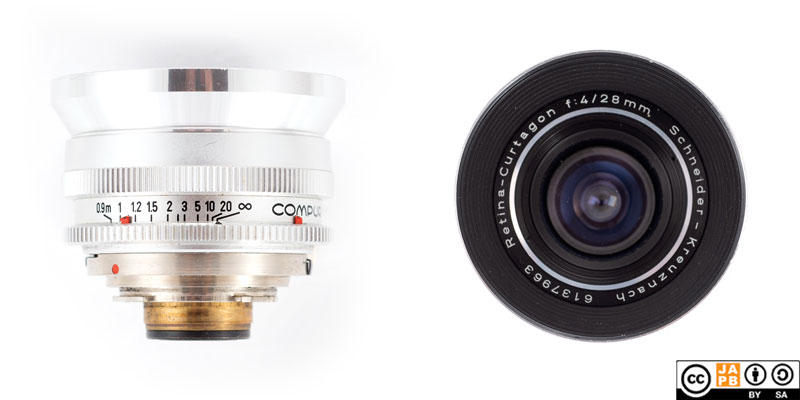Pekka Buttler, 08/2023

Pictured sample (from 1959) has distance scale in metres.
Specifications
The table below summarizes the lens’ key specifications (Measurements based on pictured sample):
| Brand: | Schneider-Kreuznach | Lens name | Retina-Curtagon f:4/28mm |
| Focal length(s) 1 | 28 mm | Angle-of-view 2 | ≈ 74 ° |
| Maximum Aperture | f/4 | In Production | 1958–1974 |
| Lens mounts | DKL | Subfamily (if applicable) | DKL/Retina |
| Length 3 | 41,6 mm | Diameter 4 | 59,8 mm |
| Filter ring diameter | N/A 5 | Weight | 234 grams |
| Lens element count | 7 | Lens group count | 6 |
| Aperture blades (S/R/C) 6 | 5 S | Focus throw | 30 ° |
| Minimum focusing distance | 90 cms | Maximum magnification | 1:30,1 |
| Has manual aperture ring | NO | Has Manual focus ring | YES |
| Aperture mechanism type | Automatic | Aperture click stops | N/A |
Further notes:
• This lens is a DKL-mount lens (see the article on the DKL mount), and therefore does not have an aperture ring (the aperture ring was on the camera-end of the mount).
• All DKL mount lenses – irrespective of manufacturer – follow a very similar design and aesthetic. Part of that design is defined by the structure of the leaf shutter integrated in the mount, but it seems that manufacturers followed a common playbook regarding colors (silver), typography, ergonomics and usability.
• While some of these aspects are admirable (such as the red ‘whiskers’ that change to indicate depth-of-field at the chosen aperture), others are a bit tedious (generally narrow, rather heavy focus rings).
• This lens is nothing less than the widest-angle lens ever offered for the DKL mount (the Rodenstock 30 mm f/2.8 Eurygon is brighter, but less wide and significantly more expensive). Considering that it dates back to 1959 – only scant years after invention of the retrofocus wide-angle – this lens is no mean achievement.
• Curtagon seems to be Schneider-Kreuznach parlance for retrofocus design moderate wide-angle (28–35mm lenses).
History of Schneider-Kreuznach
Schneider-Kreuznach is the veritabel optics decathlete, in that they have manufactured high-quality optics and lenses for pretty much every imaginable platform ranging from mobile phone camera lenses to large format lenses, enlarger, repro and macro lenses, projector lenses, cine lenses, and various industrial applications. See more in the JAPB company profile on Schneider-Kreuznach.
Versions
The Curtagon in DKL mount had a relatively long production run, and during that time one significant design change was made. Somewhere around 1968 the housing was redesigned eading to an overall more slim looking lens. At the same time, the DOF indicator whiskers were removed in favour of a more traditional (and no-doubt cheaper) painted-on DOF indication.
With the earlier version I’ve observed lenses that offer focusing scales in both feet or meters as well as both. With the later version, I’ve only ever observed both scales being present.
Adapting
To use this lens in its native environment, you will need a Kodak Retina Reflex S, III or IV or a Kodak Instamatic Reflex body. While these still exist in comfortable numbers, those numbers are dwindling. Moreover, due to the inherent complexity of the leaf shutter SLR construction, repairs will not be easy to procure.
This lens can be adapted to all mirrorless cameras using a suitable adapter. Because this lens (alike most DKL lenses) does not have an aperture ring of its own, you will need an adapter that allows you to control the lens’ aperture. As the DKL mount was of only moderate popularity, availability of DKL adapters to all mirrorless mounts cannot be taken for granted. On the other hand, one can be strategic with adapters (e.g. DKL->Canon EF; Canon EF –> mirrorless) which also opens up a wide range of special adapters (speed boosters, helicoid adapters, tilt/shift adapters).
While the flange focal distance of the DKL mount would indicate otherwise, using this lens on an SLR/dSLR is also an option (see the DKL mount article to understand why), assuming a suitable adapter can be found/manufactured. As of this writing, DKL to SLR adapters exist for at least the following mounts: Canon EF, m42, Minolta/Sony A, Nikon F, Pentax K.
Footnotes
- Focal length is (unless stated otherwise) given in absolute terms, and not in Full-frame equivalent. For an understanding of whether the lens is wide/tele, see ‘Angle-of-view’. ↩︎
- Picture angle is given in degrees (based on manufacturers’ specs) and concerns the diagonal picture angle. Rule of thumb:
> 90 ° ==> Ultra-wide-angle
70–90 ° ==> Wide-angle
50–70 ° ==> Moderate wide-angle
40–50 ° ==> ‘Standard’ or ‘normal’ lens
20–40 ° ==> Short tele lens
10-20 ° ==> Tele lens
5-10 ° ==> Long tele lens
< 5 ° ==> Ultra-tele lens ↩︎ - Length is given from the mount flange to the front of lens at infinity. ↩︎
- Diameter excludes protrusions such as rabbit ears or stop-down levers. ↩︎
- The Retina-Curtagon lacks a filter thread. Should one look for a suitable lens cap, a 58 mm lens cap can be mounted on the integrated hood. ↩︎
- S=straight; R=rounded; C=(almost)circular at all apertures. ↩︎